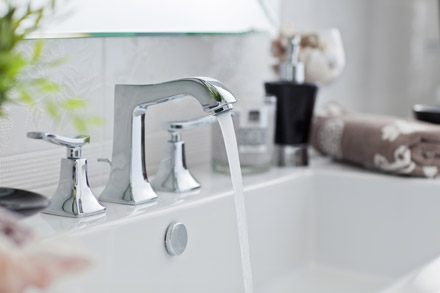Toilets are by far the main source of water use in the home, accounting for nearly 30 percent of residential indoor water consumption. Toilets also happen to be a major source of wasted water due to leaks and inefficiency. Be sure to fix toilet leaks promptly to avoid wasting water.
We do not strictly control Google ad content. If you believe any Google ad is inappropriate, please email us directly here.
Composting toilets are another option for those who want to be very green. Composting toilets have been an established technology for more than 30 years, and recent advances have made them easy to use and similar in look and feel to regular toilets. As they require little to no water, composting toilet systems can provide a solution to sanitation and environmental problems in unsewered, rural, and suburban areas.
For more information on water efficient toilets for your home, visit: http://www.epa.gov/watersense/pp/het.htm
Faucets and Showerheads
Faucets
Faucets account for more than 15 percent of indoor household water use - more than 1 trillion gallons of water across the United States each year. WaterSense labeled bathroom sink faucets and accessories can reduce a sink's water flow by 30 percent or more without sacrificing performance. If every household in the United States installed WaterSense labeled bathroom sink faucets or faucet accessories, we could save more than $350 million in water utility bills and more than 60 billion gallons of water annually (enough to meet public water demand in a city the size of Miami for more than 150 days!) If you are not in the market for a new faucet, consider replacing the aerator in your older faucet with a more efficient one. The aerator - the screw-on tip of the faucet - ultimately determines the maximum flow rate of a faucet. Aerators are inexpensive to replace and are an effective water-efficiency measure.
If you are not in the market for a new faucet, consider replacing the aerator in your older faucet with a more efficient one. The aerator - the screw-on tip of the faucet - ultimately determines the maximum flow rate of a faucet. Aerators are inexpensive to replace and are an effective water-efficiency measure.
Also keep in mind that you can significantly reduce water use by simply repairing leaks in fixtures - toilets, faucets, and showerheads - or pipes.
Showerheads
Showering accounts for approximately 17 percent of residential indoor water use in the United States - more than 1.2 trillion gallons of water consumed each year. You can purchase quality, high-efficiency shower fixtures for around $10 to $20 a piece and achieve water savings of 25-60 percent. Select a high-efficiency showerhead with a flow rate of less than 2.5 gpm (gallons per minute) for maximum water efficiency. Before 1992, some showerheads had flow rates of 5.5 gpm, so you might want to replace older models if you're not sure of the flow rate.
For more information on water-efficient faucets, showerheads, and accessories, got to:
http://www.epa.gov/watersense/pubs/ws_bathroom_faucets.html
http://www.epa.gov/WaterSense/pp/showerheads.htm
Cabinetry
Many bathroom cabinets are made from particle board, hardwood plywood paneling, or medium density fiberboard glued together using a formaldehyde-based adhesive. Formaldehyde is a common type of Volatile Organic Compound (VOC), a harmful chemical that can contribute to outdoor smog, as well as indoor air pollution. Finishes commonly used on cabinets also contain VOCs. To avoid exposure to harmful chemicals, purchase cabinetry made with formaldehyde-free adhesives and finishes.
Also, use cabinetry made from natural and sustainably harvested materials such as bamboo and certified woods (rather than tropical hardwoods). As another option, cabinets may be available through local building material reuse stores, where salvaged cabinets are routinely purchased and successfully reused. You can find local building materials reuse stores at http://www.bmra.org and http://www.habitat.org/env/restores.aspx.
Countertops
Buying recycled-content materials helps ensure that the materials collected in recycling programs will be used again in the manufacture of new products. Recycled content countertops are now widely available, and are made of attractive surfaces such as stone, glass, or other materials. For instance, countertops can be made from a material that resembles granite but consists of a biocomposite of mostly recovered newspaper and soy flour. Salvaged countertops can also be found at local building material reuse stores. You can find local building materials reuse stores at http://www.bmra.org and http://www.habitat.org/env/restores.aspx. Remember, use low-VOC sealants when installing countertops to protect the air quality in your home.
HHI Error Correction Policy
HHI is committed to accuracy of content and correcting information that is incomplete or inaccurate. With our broad scope of coverage of healthful indoor environments, and desire to rapidly publish info to benefit the community, mistakes are inevitable. HHI has established an error correction policy to welcome corrections or enhancements to our information. Please help us improve the quality of our content by contacting allen@healthyhouseinstitute.com with corrections or suggestions for improvement. Each contact will receive a respectful reply.
The Healthy House Institute (HHI), a for-profit educational LLC, provides the information on HealthyHouseInstitute.com as a free service to the public. The intent is to disseminate accurate, verified and science-based information on creating healthy home environments.
While an effort is made to ensure the quality of the content and credibility of sources listed on this site, HHI provides no warranty - expressed or implied - and assumes no legal liability for the accuracy, completeness, or usefulness of any information, product or process disclosed on or in conjunction with the site. The views and opinions of the authors or originators expressed herein do not necessarily state or reflect those of HHI: its principals, executives, Board members, advisors or affiliates.








